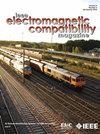New Methodology for Representing Soil Ionization in FDTD Simulations of Grounding Electrodes
IF 2
3区 计算机科学
Q3 ENGINEERING, ELECTRICAL & ELECTRONIC
IEEE Transactions on Electromagnetic Compatibility
Pub Date : 2024-12-03
DOI:10.1109/TEMC.2024.3505113
引用次数: 0
Abstract
Soil ionization has been represented in finite-difference time-domain (FDTD) simulations by the variation in resistivity in the cells depicting the soil. This approach represents the dynamics of soil ionization and its effect on the resistance of grounding electrodes, but it has a high computational cost as it requires discretizing the working volume into small cells. This article proposes a new method for representing the soil ionization effect on grounding electrodes in FDTD simulations. The electrode resistance is calculated based on the injected current using a dynamic soil ionization model, considering equipotential surface patterns and analytical expressions of the variation in soil resistivity. The resistance variation is then represented in FDTD by an equivalent radius. The method allows the use of coarse meshes and therefore fast simulations, while still considering the dynamics of soil ionization. Application examples with unipolar and bipolar injected current, single vertical rods of different lengths, and four parallel rods are used to validate the proposed method and compare it with the existing one. Results show good accuracy in all cases and a gain of up to 539 times in computing speed compared to the existing method, proving to be an efficient alternative for representing the phenomenon.接地电极时域有限差分模拟中表征土壤电离的新方法
本文章由计算机程序翻译,如有差异,请以英文原文为准。
求助全文
约1分钟内获得全文
求助全文
来源期刊
CiteScore
4.80
自引率
19.00%
发文量
235
审稿时长
2.3 months
期刊介绍:
IEEE Transactions on Electromagnetic Compatibility publishes original and significant contributions related to all disciplines of electromagnetic compatibility (EMC) and relevant methods to predict, assess and prevent electromagnetic interference (EMI) and increase device/product immunity. The scope of the publication includes, but is not limited to Electromagnetic Environments; Interference Control; EMC and EMI Modeling; High Power Electromagnetics; EMC Standards, Methods of EMC Measurements; Computational Electromagnetics and Signal and Power Integrity, as applied or directly related to Electromagnetic Compatibility problems; Transmission Lines; Electrostatic Discharge and Lightning Effects; EMC in Wireless and Optical Technologies; EMC in Printed Circuit Board and System Design.

 求助内容:
求助内容: 应助结果提醒方式:
应助结果提醒方式:


